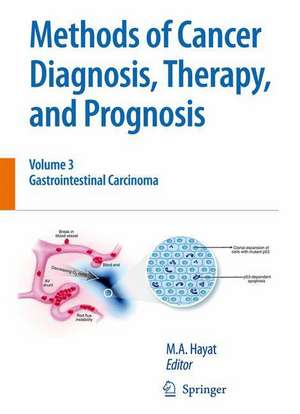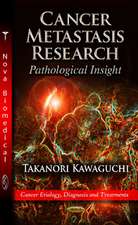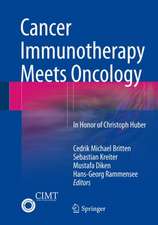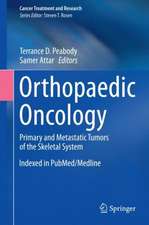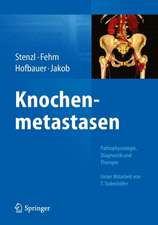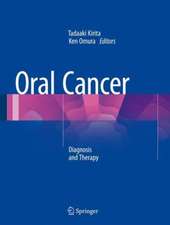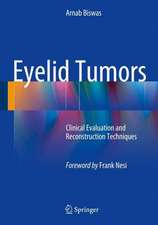Methods of Cancer Diagnosis, Therapy and Prognosis: Gastrointestinal Cancer: Methods of Cancer Diagnosis, Therapy and Prognosis, cartea 3
Editat de M. A. Hayaten Limba Engleză Hardback – dec 2008
| Toate formatele și edițiile | Preț | Express |
|---|---|---|
| Paperback (4) | 1294.08 lei 38-44 zile | |
| SPRINGER NETHERLANDS – 16 noi 2010 | 1294.08 lei 38-44 zile | |
| SPRINGER NETHERLANDS – 30 noi 2010 | 1985.54 lei 38-44 zile | |
| SPRINGER NETHERLANDS – 23 aug 2016 | 2135.52 lei 6-8 săpt. | |
| SPRINGER NETHERLANDS – 30 noi 2010 | 2597.41 lei 6-8 săpt. | |
| Hardback (4) | 1325.08 lei 38-44 zile | |
| SPRINGER NETHERLANDS – dec 2008 | 1325.08 lei 38-44 zile | |
| SPRINGER NETHERLANDS – dec 2008 | 2012.64 lei 38-44 zile | |
| SPRINGER NETHERLANDS – 14 apr 2009 | 2143.53 lei 6-8 săpt. | |
| SPRINGER NETHERLANDS – 2 dec 2008 | 2538.67 lei 38-44 zile |
Preț: 1325.08 lei
Preț vechi: 1394.82 lei
-5% Nou
Puncte Express: 1988
Preț estimativ în valută:
253.54€ • 264.75$ • 209.37£
253.54€ • 264.75$ • 209.37£
Carte tipărită la comandă
Livrare economică 11-17 aprilie
Preluare comenzi: 021 569.72.76
Specificații
ISBN-13: 9781402088995
ISBN-10: 140208899X
Pagini: 488
Ilustrații: XXXI, 247 p.
Dimensiuni: 193 x 260 x 20 mm
Greutate: 0.82 kg
Ediția:2009
Editura: SPRINGER NETHERLANDS
Colecția Springer
Seria Methods of Cancer Diagnosis, Therapy and Prognosis
Locul publicării:Dordrecht, Netherlands
ISBN-10: 140208899X
Pagini: 488
Ilustrații: XXXI, 247 p.
Dimensiuni: 193 x 260 x 20 mm
Greutate: 0.82 kg
Ediția:2009
Editura: SPRINGER NETHERLANDS
Colecția Springer
Seria Methods of Cancer Diagnosis, Therapy and Prognosis
Locul publicării:Dordrecht, Netherlands
Public țintă
Professional/practitionerCuprins
Gastrointestinal Cancers.- Introduction: Gastrointestinal Cancer.- Metastatic Gastrointestinal Cancer: Safety of Cisplatin Combined with Continuous 5-FU Versus Bolus 5-FU and Leucovorin (Methodology).- Gastrointestinal Cancer: Endoscopic Submucosal Dissection (Methodology).- Gastrointestinal Epithelial Neoplasms: Endoscopic Submucosal Dissection (Methodology).- Inoperable Abdomino-Pelvic Tumors: Treatment with Radio-Frequency Ablation and Surgical Debulking.- Gastrointestinal Neuroendocrine Tumors: Diagnosis Using Gastrin Receptor Scintigraphy.- Esophageal Cancer.- Distal Esophagus: Evaluation with 18F-FDG PET/CT Fusion Imaging.- Endoscopic Ultrasound and Staging of Esophageal Cancer.- Esophageal Cancer: Role of RNASEN Protein and microRNA in Prognosis.- Esophageal Cancer: Initial Staging.- Gastric Cancer.- Automated Disease Classification of Colon and Gastric Histological Samples Based on Digital Microscopy and Advanced Image Analysis.- Early Gastric Cancer: Prediction of Metachronous Recurrence Using Endoscopic Submucosal Dissection (Methodology).- Helicobacter pylori-Infected Neoplastic Gastric Epithelium: Expression of MUC2 as a Biomarker.- Gastric Cancer: Role of Intestinal Metaplasia by Histochemical Detection Using Biopsy Specimens.- Gastric Cancer: Antitumor Activity of RUNX3.- Early Gastric Cancer: Laparoscopic Gastrectomy (Methodology).- Gastric Cancer: Overexpression of Hypoxia-Inducible Factor 1 as a Prognostic Factor.- Pancreatic Cancer.- Pancreatic Cancer: Hepatoma-Derived Growth Factor as a Prognostic Factor.- Pancreatic Cancer: 18F-Fluorodeoxyglucose Positron Emission Tomography as a Prognostic Parameter.- Imaging and Pathologic Findings of Peculiar Histologic Variants of Pancreatic Endocrine Tumors.- Periampullary Adenocarcinoma: Diagnosis and SurvivalAfter Pancreaticoduodenectomy.- Unresectable Locally Advanced Pancreatic Cancer: Concurrent Chemotherapy.
Textul de pe ultima copertă
This third volume in the series Methods of Cancer Diagnosis, Therapy and Prognosis discusses diagnosis, therapy, and prognosis of Gastrointestinal Cancers. Both standard and emerging therapies for these cancers, written by expert oncologists/pathologists in this field, are included.
This fully illustrated volume
* Includes various aspects of esophageal cancer, gastric cancer, and pancreatic cancer
* Highlights the methodologies used for diagnosis, therapy, and prognosis of these different cancers
* Explains the molecular mechanisms underlying these cancers
* Discusses the evaluation of FDG-PET/CT fusion imaging, endoscopic ultrasound and imaging, and the role of microRNA in prognosis
* Details the classification of colon and gastric histological samples
* Highlights treatments, including radiofrequency ablation and surgical debulking, endoscopic submucosal dissection, laparoscopic gastrectomy of gastric cancer and pancreaticoduodenectomy
* Reviews use of radiotherapy and chemotherapy for pancreatic cancer patients
* Discusses a large number of imaging modalities for diagnosing these cancers and assessing the different treatments
Professor Hayat has summarized the problems associated with the complexities of research publications and has been successful in editing a must-read volume for oncologists, cancer researchers, medical teachers and students of cancer biology.
This fully illustrated volume
* Includes various aspects of esophageal cancer, gastric cancer, and pancreatic cancer
* Highlights the methodologies used for diagnosis, therapy, and prognosis of these different cancers
* Explains the molecular mechanisms underlying these cancers
* Discusses the evaluation of FDG-PET/CT fusion imaging, endoscopic ultrasound and imaging, and the role of microRNA in prognosis
* Details the classification of colon and gastric histological samples
* Highlights treatments, including radiofrequency ablation and surgical debulking, endoscopic submucosal dissection, laparoscopic gastrectomy of gastric cancer and pancreaticoduodenectomy
* Reviews use of radiotherapy and chemotherapy for pancreatic cancer patients
* Discusses a large number of imaging modalities for diagnosing these cancers and assessing the different treatments
Professor Hayat has summarized the problems associated with the complexities of research publications and has been successful in editing a must-read volume for oncologists, cancer researchers, medical teachers and students of cancer biology.
Caracteristici
The only book that discusses cancer diagnosis, therapy, and prognosis together in one volume Discusses the molecular processes that lead to the development and proliferation of cancer cells Recent major advances in cancer diagnosis and therapy are included The text is supported throughout with illustrations The information identifies patients with high likelihood of clinical benefits from a specific treatment
Recenzii
"Once more Professor Hayat has to be congratulated for bringing together 56 leading scientists representing 16 countries in the field of breast cancer, which has made it possible to publish such an excellent book. It represents a valuable addition to the available literature on breast cancer treatment since it covers all aspects of breast cancer, including diagnosis, treatments, and prognosis. Thereby, not only efficacy of various anticancer drugs and their side-effects are pointed out, but also the necessity of age-dependent breast cancer strategies is highlighted. Therefore, I conclude that this book is a true benefit to all clinicians, surgeons, and oncologists working in the field of breast cancer."
Professor Dr. Thomas Dittmer
Institute of Immunology
Witten/Herdecke University
Witten, Germany
"This first volume of the Handbook on Methods of Cancer Diagnosis, Therapy, and Prognosis, concerns problems related to diagnosis, treatment, monitoring of therapy, and prognosis in breast cancer. This is an impressive monograph containing data range on novel techniques (e.g., PET examination of sentinel lymph nodes) used in early diagnosis, prognosis (Molecular studies on circulating neoplastic cells), and treatment (surgery, chemo-radio-and hormontherapy) of various histological types of breast cancer. This monograph resulting from cooperative efforts of 56 authors from 16 countries (specialists in this field) cannot be matched by any publication of this type. The oncologists, pathologists, and scientists engaged in problems of breast cancer should have this extremely valuable Handbook at hand."
Professor Piotr Dziegiel
Department of Histology and Embryology
Medical University of Wroclaw, Poland
"It has been a great pleasure to review the forthcoming book, Methods of Cancer Diagnosis, Therapy, and Prognosis: Volume 1, edited by Professor M.A. Hayat. Dr. Hayat is a Distinguished Professor in the Department of Biological Sciences, Kean University, Union, New Jersey. After seeing the chapters listed in his book, I am very impressed by the thoroughness of the topics in the proposed book. As an editor, Dr. Hayat has assembled a group of well known researchers and clinicians from many parts of the world to write the state-of-the art chapters on breast cancer, including but not limited to the chapters, on computer-assisted diagnosis, familial breast cancer, serum markers in diagnosis, circulating cancer cells before and after treatments, epigenetic markers, metastasis and its detection, validation of biomarkers, immunohistochemistry, invasive cancer and treatments. He has summarized the problems associated with the complexities of research publications which are not easy reading even for many scientists and clinicians. The subject matter is, undoubtedly, complex and formidable for many breast cancer patients.
The current consolidated information on breast cancer research is not readily available. The numbers of cancer cases are projected to increase significantly by 2030, especially in low and middle income countries. Even in the advanced countries, there is a population of low and middle income people who do not have access to appropriate diagnosis and treatment. These people suffer from the same problems as those belonging to the low and middle income countries. Dr. Hayat has provided data in his preface showing that some cancers can be reduced by changes in lifestyle and education. His assessment is very timely.
With best wishes and regards to Dr. Hayat."
Akhouri A. Sinha, Ph.D. Professor of Genetics, Cell Biology and Development, The University of Minnesota and Research Scientist at the Veterans Affairs Medical Center, Minneapolis, Minnesota.
"Professor Hayat has done it again! He has edited (METHODS OF CANCER DIAGNOSIS, THERAPY, AND PROGNOSIS, to be published by Springer) a comprehensive treatise on diagnosis, therapy, recurrence, resistance along with risk benefit ratio in cancers with special emphasis on breast cancer. Scientists and clinicians from the world over have contributed the latest advances in their respective areas of expertise. The reader is provided with a whole field view of the state of the art in breast cancer management. This treatise will serve as a must read for oncologists, scientist researchers and students of cancer biology. I look forward to the next series dealing with epidemiology, genetic predisposition and the role of the tumor microenvironment in cancer biology."
Debabrata Banerjee Ph.D
Associate Professor
Medicine and Pharmacology
Cancer Institute of New Jersey, New Brunswick
Professor Dr. Thomas Dittmer
Institute of Immunology
Witten/Herdecke University
Witten, Germany
"This first volume of the Handbook on Methods of Cancer Diagnosis, Therapy, and Prognosis, concerns problems related to diagnosis, treatment, monitoring of therapy, and prognosis in breast cancer. This is an impressive monograph containing data range on novel techniques (e.g., PET examination of sentinel lymph nodes) used in early diagnosis, prognosis (Molecular studies on circulating neoplastic cells), and treatment (surgery, chemo-radio-and hormontherapy) of various histological types of breast cancer. This monograph resulting from cooperative efforts of 56 authors from 16 countries (specialists in this field) cannot be matched by any publication of this type. The oncologists, pathologists, and scientists engaged in problems of breast cancer should have this extremely valuable Handbook at hand."
Professor Piotr Dziegiel
Department of Histology and Embryology
Medical University of Wroclaw, Poland
"It has been a great pleasure to review the forthcoming book, Methods of Cancer Diagnosis, Therapy, and Prognosis: Volume 1, edited by Professor M.A. Hayat. Dr. Hayat is a Distinguished Professor in the Department of Biological Sciences, Kean University, Union, New Jersey. After seeing the chapters listed in his book, I am very impressed by the thoroughness of the topics in the proposed book. As an editor, Dr. Hayat has assembled a group of well known researchers and clinicians from many parts of the world to write the state-of-the art chapters on breast cancer, including but not limited to the chapters, on computer-assisted diagnosis, familial breast cancer, serum markers in diagnosis, circulating cancer cells before and after treatments, epigenetic markers, metastasis and its detection, validation of biomarkers, immunohistochemistry, invasive cancer and treatments. He has summarized the problems associated with the complexities of research publications which are not easy reading even for many scientists and clinicians. The subject matter is, undoubtedly, complex and formidable for many breast cancer patients.
The current consolidated information on breast cancer research is not readily available. The numbers of cancer cases are projected to increase significantly by 2030, especially in low and middle income countries. Even in the advanced countries, there is a population of low and middle income people who do not have access to appropriate diagnosis and treatment. These people suffer from the same problems as those belonging to the low and middle income countries. Dr. Hayat has provided data in his preface showing that some cancers can be reduced by changes in lifestyle and education. His assessment is very timely.
With best wishes and regards to Dr. Hayat."
Akhouri A. Sinha, Ph.D. Professor of Genetics, Cell Biology and Development, The University of Minnesota and Research Scientist at the Veterans Affairs Medical Center, Minneapolis, Minnesota.
"Professor Hayat has done it again! He has edited (METHODS OF CANCER DIAGNOSIS, THERAPY, AND PROGNOSIS, to be published by Springer) a comprehensive treatise on diagnosis, therapy, recurrence, resistance along with risk benefit ratio in cancers with special emphasis on breast cancer. Scientists and clinicians from the world over have contributed the latest advances in their respective areas of expertise. The reader is provided with a whole field view of the state of the art in breast cancer management. This treatise will serve as a must read for oncologists, scientist researchers and students of cancer biology. I look forward to the next series dealing with epidemiology, genetic predisposition and the role of the tumor microenvironment in cancer biology."
Debabrata Banerjee Ph.D
Associate Professor
Medicine and Pharmacology
Cancer Institute of New Jersey, New Brunswick
